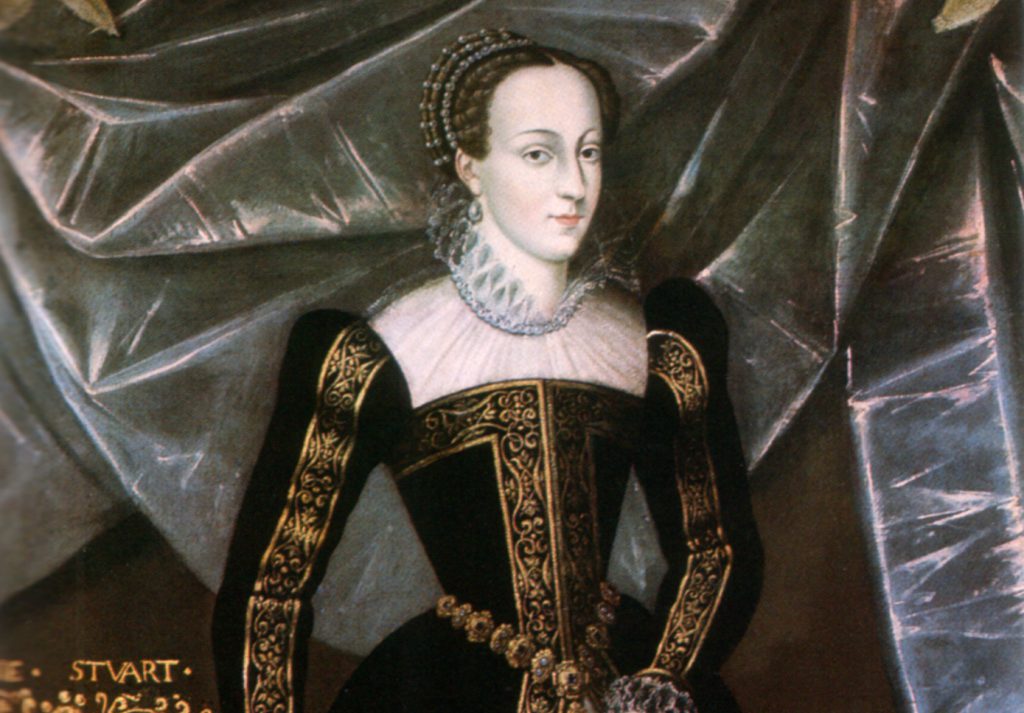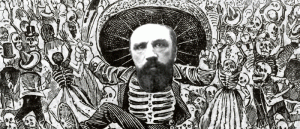Have you ever wanted something so bad you would do anything to get it? What if that goal was a crown and a whole kingdom? What would you do? Would your actions be worth it in the end if you did something that could potentially ruin your life, or even end it? Sometimes our ambitions make us act recklessly in order to achieve our goal. And in the end the results could be disastrous. As the song from the Rolling Stones says, “you can’t always get what you want,” and that is what Mary Stuart, Queen of Scotland learned the hard way when she fought for the English throne, and in the end, lost her life.
Mary Stuart was born on December 7, 1542 to King James V of Scotland and Mary of Guise1 She was the only living child of King James V, so she became the heir to the throne, and then Queen shortly after her birth, when her father died. As the granddaughter of Margaret Tudor, sister to Henry Tudor VIII King of England, she was next in line for the English throne. Because of her ties to the throne of England, she was often pushed to become the Queen of both Scotland and England.
In her attempt to become the next heir to the English throne after her cousin Elizabeth, Mary decided to wed someone who would strengthen her claim to the throne. This was a danger to Queen Elizabeth’s reign, because the people Mary considered to be a potential husband made Mary’s claim even stronger, because she would then have a husband, where Elizabeth did not. In order to gain Queen Elizabeth’s favor, Mary had considered marrying someone that Elizabeth chose for her, but when Elizabeth suggested Lord Dudley for her, the favored Earl of Leicester, Mary decided against it. Instead, she married her cousin, Henry Stuart, or Lord Darnley, who also had a claim to the English throne through his grandmother Margaret Tudor.2
This led to a rebellion in Scotland because Protestants believed that the marriage of Mary to Lord Darnley would bring Catholicism back to Scotland and England because their claim to the English throne was stronger. The rebellion was led by Mary’s half-brother James Stuart, but was defeated by Mary. This was the start of her growing unpopularity in Scotland.3 When she first met Lord Darnley, she had thought that he was charming, and quickly arranged for their marriage. But after they married, she found that his attitude was completely different. Her marriage quickly became unhappy. Lord Darnley was a drunkard and was a jealous, stubborn, immature man. Because of his immaturity, Queen Mary refused to give him the crown matrimonial, which would have allowed him to rule Scotland, and this angered him.
Mary started avoiding him, and eventually she started spending a great amount of time with some of her advisers and secretaries, particularly David Riccio. Riccio was her secretary for French correspondence, and he quickly gained influence with the Queen and her policies.4 The amount of time Queen Mary spent with Riccio created rumors that she was having an affair with the secretary and that the baby she was carrying belong to Riccio. A group confronted Lord Darnley and put this rumor in his ear. This, combined with jealousy, infuriated Lord Darnley, who created a plot to kill Riccio. In 1566, Lord Darnley, along with the group, surprised the Queen, Riccio, and a countess at dinner, and dragged Riccio out of the room and stabbed him repeatedly, killing him.5 It is also argued that Mary also could have been a target, but there is no clear evidence.
After this event Mary never forgave Lord Darnley, and their relationship became even more strained. Their son, James, who would become James I of England, was born in June 1566, and his birth did nothing to improve their relationship.6 Mary made sure that Lord Darnley would never forget what he had done, by making comments such as the ones she made when their son was born: “My Lord, God has given you and me a son, begotten by none but you. Here I protest to God as I shall answer to him… that this is your son and no other man’s son.”7 Mary would continue to push Lord Darnley away and would completely leave him out of meetings. She decided that his presence was no longer needed, and she began looking for a way to annul their marriage. Out of fear for her son’s claim to the throne, Mary was hesitant to get an annulment.

In the meantime, the Queen met and befriended another councilor, James Hepburn, the Lord Bothwell. It was also believed that the Queen was having an affair with Lord Bothwell. On February 10, 1567, Lord Darnley was killed.8 It appeared that Lord Darnley was killed when the house he was staying at had exploded, but it was later discovered that he was killed somewhere else entirely and by suffocation. Automatically, the suspicion fell on Lord Bothwell, and it is speculated that Mary also had a role in the murder.9 There is evidence that could possibly connect Mary to helping Lord Bothwell plot the death of her husband, known as the Casket Letters, but there is still not enough evidence. To this day it is still unknown whether the Queen of Scotland had a role in Lord Darnley’s murder. The rumors of an affair between Queen Mary and Lord Bothwell became stronger when she refused to convict Lord Bothwell, and he was subsequently acquitted of all charges, despite the advice of Queen Elizabeth and her former mother-in-law, Catherine Medici of France.10
Shortly after, Mary and Lord Bothwell married, which to many only confirmed the rumors. Mary claimed that Lord Bothwell abducted, raped, and forced her into the marriage.11 Like her last marriage, she was not happy. She appeared to regret marrying Lord Bothwell and seemed depressed, listless, and would often talk of suicide. Her marriage was the last straw for what little supporters she had left, and a civil war broke out in Scotland. By June, the Earl of Moray had an army to fight Queen Mary and Lord Bothwell under the banner of the murdered Lord Darnley and their son James.12 The rebels believed that Mary was no longer fit to rule because of the marriage. When she was captured at Carberry Hill, she was given the choice to keep the throne if she gave up Lord Bothwell. When she refused the offer, even her own army began to desert her. Lord Bothwell was able to escape, but the Queen was captured and taken prisoner to Edinburgh.13 On July 24, Mary was forced to abdicate the throne to her son James, and his regency would be given to the Earl of Moray.
Mary escaped Scotland to England shortly after, and begged her cousin, Queen Elizabeth, for sanctuary. Queen Elizabeth’s advisers warned her against it, because they thought she was a threat, but Queen Elizabeth allowed her to stay. While in England, Mary was under investigation again for the murder of her husband Lord Darnley, and due to the lack of evidence, she was not convicted. While in England, she was kept almost like a prisoner, under house arrest for the next eighteen years, without being able to contact her son, the now King of Scotland.14 She would spend most of her time knitting, but that was not all she was doing.

Some of Queen Elizabeth’s advisers had been keeping an eye on Mary, and they discovered three plots against Queen Elizabeth that would seal Mary’s fate. The first plot, known as the Ridolfi plot, was a conspiracy with Thomas Howard and King Philip of Spain, to assassinate Queen Elizabeth and make Mary Queen of England.15 Letters discussing the plot were intercepted by one of Queen Elizabeth’s advisers and the plot was foiled. The Queen’s advisers pushed her to punish Mary, but she refused because the evidence was not certain. In the end, Howard was executed and Mary remained a prisoner. The second plot was called the Throckmorton plot. In this the French were to invade England and assassinate Queen Elizabeth. From this, Parliament created an act for the Queen’s safety. In this act, if the Queen was killed, any party responsible would be tried and executed.16 In the final plot, Mary was caught in the act by an undercover agent who found the letters that incriminated Mary Stuart. Queen Elizabeth’s advisers strongly pushed for her to sign Mary’s death warrant, but she hesitated because she did not want the controversy of executing a queen. In the end, she reluctantly signed the warrant and on February 8, 1587, Mary was beheaded without the Queen’s knowledge.17
From the beginning, Mary Stuart had wanted the English throne and she made decisions that she thought would make her a better candidate for that throne. She thought the best way to gain the crown was through marriage, but in the end you could argue that that was the beginning of her downfall. You could say she most certainly did not get what she wanted.

- Elizabethan World Reference Library, 2007, s.v. “Stuart, Mary.” ↵
- Elizabethan World Reference Library, 2007, s.v. “Stuart, Mary. ↵
- Elizabethan World Reference Library, 2007, s.v. “Stuart, Mary.” ↵
- Women in World History: A Biographical Encyclopedia, 2002, s.v. “Mary Stuart (1542-1587),” by Kimberly Estep Spangler. ↵
- Women in World History: A Biographical Encyclopedia, 2002, s.v. “Mary Stuart (1542-1587),” by Kimberly Estep Spangler. ↵
- Women in World History: A Biographical Encyclopedia, 2002, s.v. “Mary Stuart (1542-1587),” by Kimberly Estep Spangler. ↵
- Women in World History: A Biographical Encyclopedia, 2002, s.v. “Mary Stuart (1542-1587),” by Kimberly Estep Spangler. ↵
- Encyclopedia of World Biography, 2004, s.v. “Mary Queen of Scots.” ↵
- Encyclopedia of World Biography, 2004, s.v. “Mary Queen of Scots.” ↵
- Encyclopedia of World Biography, 2004, s.v. “Mary Queen of Scots.” ↵
- Women in World History: A Biographical Encyclopedia, 2002, s.v. “Mary Stuart (1542-1587),” by Kimberly Estep Spangler. ↵
- Women in World History: A Biographical Encyclopedia, 2002, s.v. “Mary Stuart (1542-1587),” by Kimberly Estep Spangler. ↵
- Women in World History: A Biographical Encyclopedia, 2002, s.v. “Mary Stuart (1542-1587),” by Kimberly Estep Spangler. ↵
- Encyclopedia of World Biography, 2004, s.v. “Mary Queen of Scots.” ↵
- Elizabethan World Reference Library, 2007, s.v. “Stuart, Mary.” ↵
- Elizabethan World Reference Library, 2007, s.v. “Stuart, Mary.” ↵
- Elizabethan World Reference Library, 2007, s.v. “Stuart, Mary.” ↵



52 comments
Tyler Reynolds
I like the use of a question as a introduction(as I have yet to see another article use this same technique) but I still believe that this type of attention grabber is not the most effective. The author could have used more and better sources. There are some sentences structured in the article in a unnatural and very confusing manner. The reader has to reread said sentence two to three times to understand what the author is trying to convey. This results in a bumpy story and ruins the quality of the article.
Christopher Hohman
Nice article. Mary Queen of Scot’s life was quite tragic. Her father died when she was just a week old, and if you believe the legend he actually died because he found out he was having a girl as a child. Her ambition was quite deadly because I believe that Elizabeth was much smarter than her, but her choice of men was also extremely poor. It sad that she died at Elizabeth’s own will, but in the end her son James VI inherited the English throne. Congratulations on your nomination.
Christopher Metta Bexar
I reread this because I’ve always been interested in Elizabeth I. What I had forgotten in my first reading was that Mary not only had to deal with Elizabeth, but with Charles V of Spain, and her very dangerous mother in law from her first marriage, Catherine de Medici, one of the most dangerous women in history when provoked.
How Mary survived let alone prospered is amazing. Elizabeth and she both seemed to appear to be surrounded by vipers looking out for their own interests and not those of the queen.
Nadia Carrasco
Not knowing much about Mary Queen of Scotts this article taught me a lot. Mary Queen of Scotts lived a fascinating life in Scotland. She was banished from her country and moved to France when she was just a baby, and was complete stranger in her own homeland. I can only imagine what she felt all throughout her childhood. Although her life ended so horribly her son a Kind of England can now make her proud.
Engelbert Madrid
The ambition for power and wealth are certainly things that would ruin the life of a person who’s mind is only revolving for more glory. Queen Mary of Scotland had the privileged to be living as a high-class woman; however, she was only concern for more power that she wanted to attain in Scotland and in England. Because of her greed, her life ended in a way that could have been avoided in the first place. Great article.
Samantha Ruvalcaba
It’s strange to think of a time where arranged marriages made allies.I’m glad you mentioned things like this because they give more of a profile on who Mary was and why she made the moves she did. It’s also interesting to read about the phenomena accusations of affairs can do to households and reigns. For Mary, it wasn’t a good look. Well done
Christopher Metta Bexar
A very interesting article on Mary and Elizabeth. What some of us forget at times is that at some point, according to some, Mary should have been Queen of Britain and Scotland.
Her legitimacy was never questioned,though some historians claim Henry VIII had Elizabeth declared a bastard when her mother was executed for treason. This would have made Mary automatically the heir to the throne behind prince Edward.
Mary had a tragic life One thing I had not known before reading this article was that James was not the son of the Dauphin. I knew Mary had been bethrothed by her mother to the heir to the French throne.
Fatima Navarro
Nice article! I was actually feeling pity for Queen Mary due to her “suffering” after marrying Lord Bothwell. Even though is all speculation, I think i was all an act, from leaving Scotland to finding “refuge” in Queen’s Elizabeth’s kingdom, all for the purpose of one day assassinating her cousin and taking over everything. I enjoy reading these type of stories, therefore I enjoyed yours.
Antonio Coffee
What really struck me about this article was not the ambition of Mary but rather the forgiveness and trust of Elizabeth. Elizabeth was willing to trust Mary in spite of her being a threat to the throne and when plots were uncovered she was not wanting to blame it on Mary until Mary herself was caught in the act. Even at that point, Elizabeth was reluctant to order her execution until she was pressured by her advisors. Elizabeth did everything she could for Mary.
Sarah Uhlig
I remember watching the movie that they made recently about Queens Mary and Elizabeth. I really enjoyed the movie and the article you have written because of how interesting her story is. Her story is very unfortunate with how she ended up being murdered for her attempts to rule all the land that she could, but her efforts in her early reign were soon defeated. Her story was very tragic, but very important in the history of Scotland.
Danielle Slaughter
I love stories of royal women from this time period in English history, as it shows just how far some of us are willing to go to get what we want. Unfortunately for Mary, her plans for securing the throne through marriage simply didn’t come through, and this coupled with her conspiracies against her cousin Queen Elizabeth led to the loss of her life. One could argue that she was simply a product of her environment, but this was definitely a fascinating article.